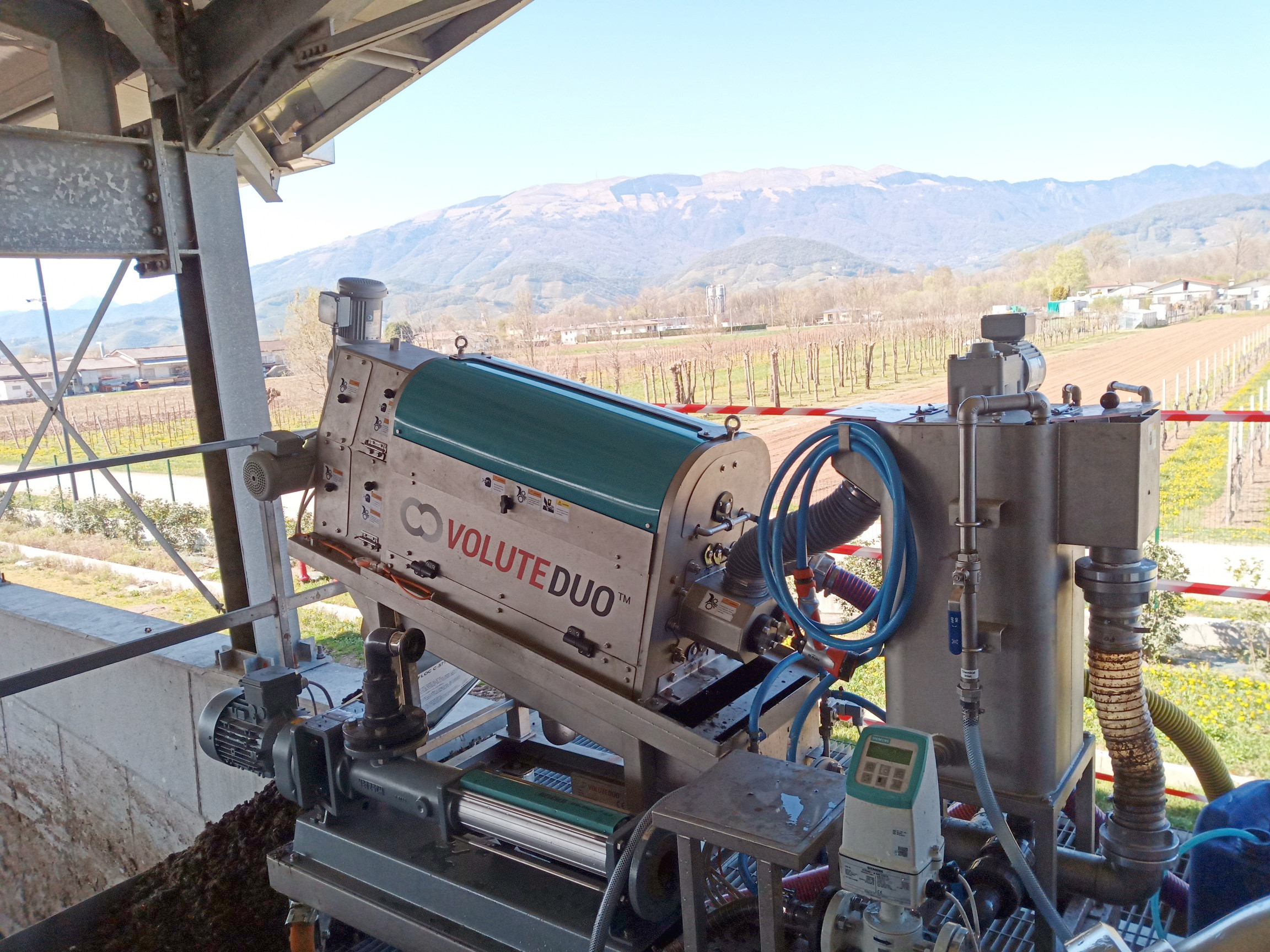
A must-read piece for those interested in learning more about activated sludge and how it is processed. This article explains the role of activated sludge, how the treatment process works, its various types, and the importance of proper sludge management. By reading this, you’ll gain a solid understanding of wastewater treatment using the activated sludge method.
Activated sludge plays a vital role in the purification process of sewage and industrial wastewater. Many professionals may be seeking a deeper understanding of activated sludge and its associated treatment methods.
This article provides an easy-to-understand explanation of the basics of activated sludge, how the activated sludge process works, its types, system components, and key points in microbial management.
Let’s explore the roles, differences in treatment methods, and maintenance practices of activated sludge to help achieve proper wastewater treatment.
Contents
- 1 What is Activated Sludge? | The Role of Microorganisms in Wastewater Treatment
- 2 How Activated Sludge Decomposes Organic Matter in Wastewater
- 3 Types and Characteristics of Activated Sludge Processes
- 3.1 Advantages and Disadvantages of Activated Sludge Processes
- 3.2 Type 1: Conventional Activated Sludge Process (Standard Type)
- 3.3 Type 2: Oxidation Ditch (OD) Method (Ther simple method of treatment)
- 3.4 Type ③: Membrane Bioreactor (MBR) – A Method Suitable for Advanced Treatment
- 3.5 Type ④: Sequencing Batch Reactor (SBR) – A Method That Allows Flexible Operation
- 4 General Flow of Wastewater Treatment Using Activated Sludge
- 5 Key Points for Maintaining Healthy Activated Sludge
- 5.1 Maintaining the Health of Microorganisms in Activated Sludge
- 5.2 Maintaining Optimal Conditions for Temperature, pH, and Dissolved Oxygen
- 5.3 Balancing Nutrients for Microbial Efficiency
- 5.4 Prevention of Sedimentation Problems (Bulking and Floating Sludge)
- 5.5 Equipment Inspections to Ensure Consistent Treatment Result
- 6 Conclusion|Understand and Manage Activated Sludge for Effective Wastewater Treatment
What is Activated Sludge? | The Role of Microorganisms in Wastewater Treatment
First, we will explore the intricate nature of activated sludge, which helps decompose organic matter in wastewater, focusing on the following three points.
Activated Sludge
Activated sludge is a mass of microorganisms used to cleanse contaminated water, such as sewage and industrial wastewater. It consists of a variety of bacteria, protozoa, and metazoans forming aggregates known as “flocs.” These microorganisms consume and break down organic matter in the water as their food source. The types and activity levels of the microorganisms in activated sludge change depending on the season and characteristics of the wastewater. Maintaining the activity of the sludge is essential for stable wastewater treatment.
Main Microorganisms in Activated Sludge
Activated sludge is a biological community made up of bacteria, protozoa, and metazoans. These organisms work together to decompose and purify contaminants in wastewater.
Bacteria are the main agents of purification, feeding on organic matter and aiding decomposition. Protozoa and metazoans contribute by consuming bacteria and suspended organic matter, further assisting in the purification process.
Protozoa, easily observed under a microscope, are important indicators of sludge health. They are generally classified into three major groups: amoeboids, flagellates, and ciliates.
The basics of activated sludge decomposing organic matter
The decomposition process begins in an aeration tank where air is supplied to aerobic microorganisms, thereby creating an environment suited for the breakdown of organic matter.
As these microorganisms consume organic matter, they begin multiplying to form flocs. The wastewater containing these flocs is then sent to a settling tank, where the flocs sink to the bottom by gravity, leaving clear water on top. The treated water is then tested whether it meets discharge standards – if so, it can be safely released.
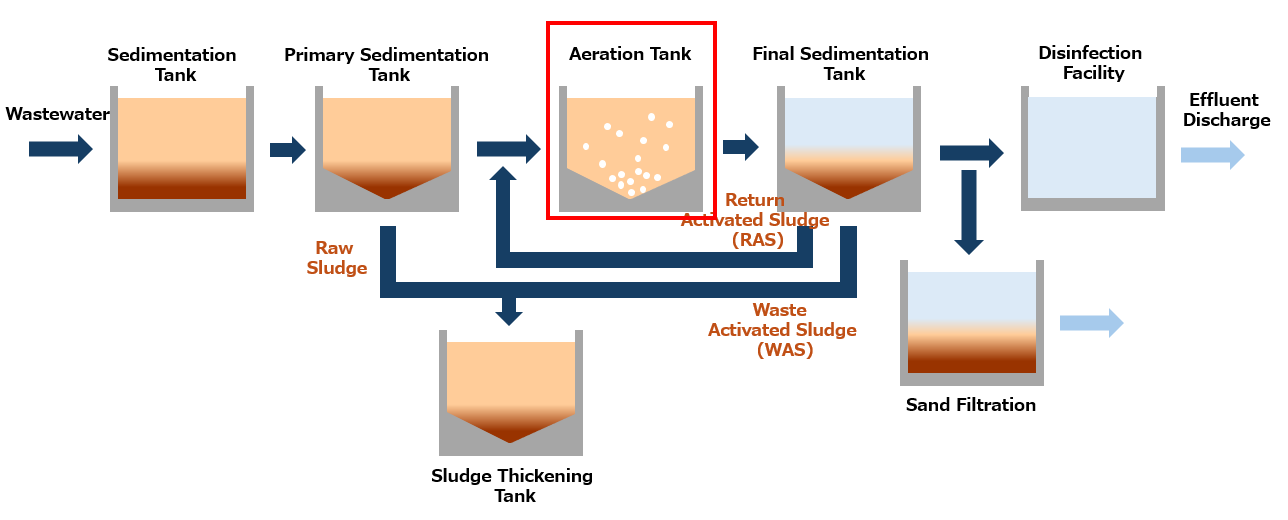
How Activated Sludge Decomposes Organic Matter in Wastewater
The decomposition of organic matter in wastewater using activated sludge involves three main steps:
- Mechanism of Organic Matter Uptake and Digestion
- Importance of Floc Formation by Microorganisms
- Sedimentation and Separation of Flocs and Treated Water
We will explore these in a more in-depth manner below:
Mechanism of Organic Matter Uptake and Digestion
Microorganisms in activated sludge decompose organic matter through a simple process: they “eat” the organics.
They first absorb dissolved or suspended organic matter into their cells as nutrients. Inside the cells, enzymes break down this material into simpler substances, which are then used to sustain microbial life.
Importance of Floc Formation by Microorganisms
In the aeration tank, aerobic microorganisms multiply while breaking down organics and form flocs using secreted mucus. These flocs range in size from several micrometers to a few millimeters and contain not only bacteria but also protozoa like Vorticella and Rotifera.

Proper floc formation is critical for effective wastewater treatment, particularly for efficient settling in the sedimentation tank after purification.
Sedimentation and Separation of Flocs and Treated Water
Efficient separation of flocs from wastewater is key to purification. After decomposition, the wastewater is transferred from the aeration tank to a sedimentation tank.
Here, the flocs settle to the bottom by gravity, leaving clear treated water on top. If this water meets quality standards, it can be discharged.
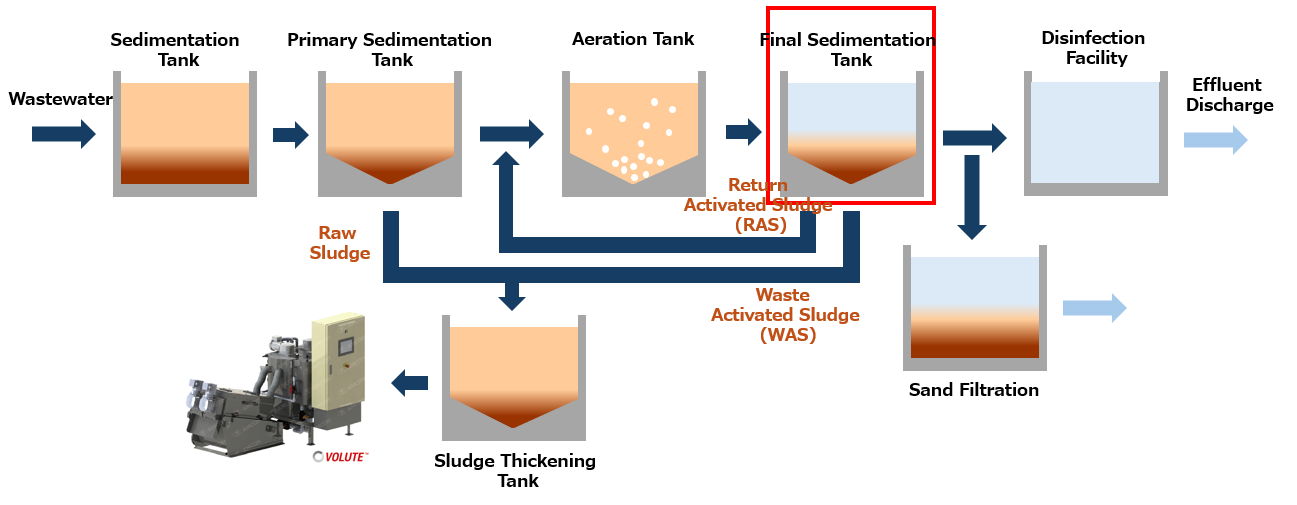
Some of the settled sludge is returned to the aeration tank to maintain microbial concentration, while excess sludge—known as “waste activated sludge”—is removed to prevent overcrowding and decreased efficiency.
WAS and primary sludge, which are mostly water (95–99%), are sent to a thickening tank and then dewatered to about 80% moisture content before being incinerated. Our VOLUTE™ Dewatering Press integrates thickening and dewatering into one unit, allowing direct input without a thickening tank, thus reducing equipment and operating costs.

Types and Characteristics of Activated Sludge Processes
Types and Characteristics of Activated Sludge Processes
Advantages and Disadvantages of Activated Sludge Processes
The advantages of the activated sludge process include high treatment efficiency and stable purifications. It can rapidly break down large amounts of organic matter and produce water of such quality that it can be reused. With proper operational management and measures against bulking, odor generation can be minimized, making it suitable for urban installation.
On the other hand, there are also disadvantages. Supplying the oxygen needed to maintain microbial activity requires significant energy, which increases operating costs. Additionally, because microorganisms are sensitive to changes in water quality and temperature, constant and appropriate management is essential. Sustained stable treatment requires specialized knowledge and continuous monitoring.
Type 1: Conventional Activated Sludge Process (Standard Type)
The conventional activated sludge process is by far the most basic treatment method among activated sludge systems. Because its design and operation are standardized, it offers relatively high treatment efficiency and stable wastewater purification.
Its key feature is a system that combines an aeration tank and a sedimentation tank. In this setup, microorganisms decompose organic matter in the aeration tank, and the resulting flocs (microbial aggregates) are separated from the treated water in the sedimentation tank, establishing a continuous flow process.However, while it provides flexibility to handle various types of wastewater, it requires careful management in response to fluctuations in water quality.
Type 2: Oxidation Ditch (OD) Method (Ther simple method of treatment)
The Oxidation Ditch method (OD method) is one of the more simpler types of activated sludge processing. In the OD method, a primary settling tank is not used initially. Instead, a shallow, circular channel equipped with mechanical aerators serves as the reaction tank. By operating under low-load conditions, the process efficiently breaks down organic matter in the water.
Furthermore, since the aeration tank alternates between aerobic and anoxic conditions, both nitrification and denitrification occur simultaneously. This enables the effective removal of not only organic matter but also nitrogen—one of the method’s major advantages.
Thanks to its simple structure, the OD method is known for being cost-effective to construct, easy to maintain, and capable of achieving high treatment efficiency. With the introduction of our VOLUTE™ Dewatering Press, even greater cost savings and space efficiency have become possible.
VOLUTE ™ overturns the conventional practice of “thickening sludge before dewatering” by enabling direct dewatering of low-concentration sludge straight from the OD tank—known as the “Direct Dewatering Method from the OD Reaction Tank.” This innovation eliminates the need for separate thickening and storage tanks, allowing for a simpler and more cost-efficient facility design.This “Direct Dewatering Method from the OD Reaction Tank” has been widely adopted in small-scale sewage treatment facilities across Japan and is highly regarded for its effectiveness.
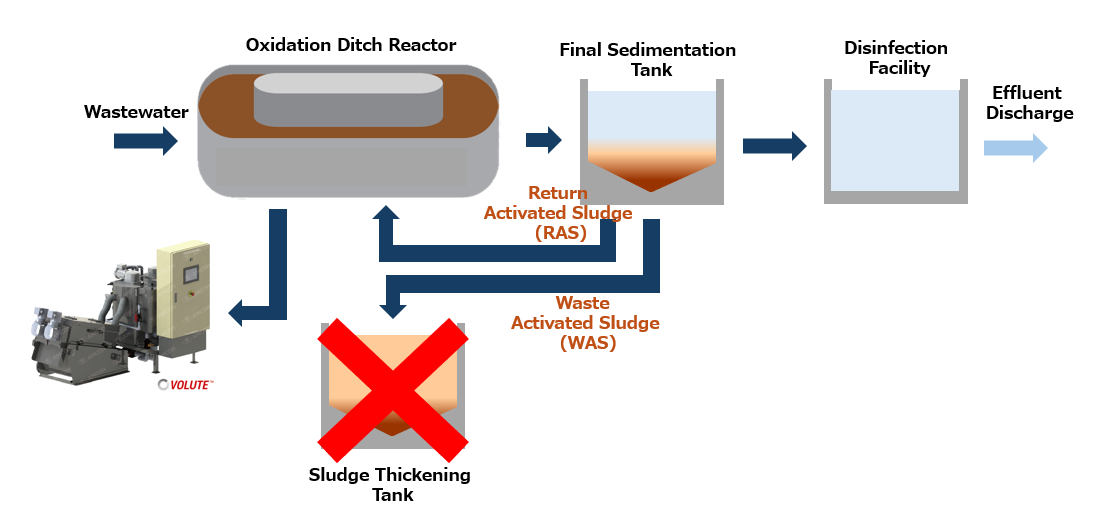
Type ③: Membrane Bioreactor (MBR) – A Method Suitable for Advanced Treatment
In conventional activated sludge processes, poor sludge settling in the sedimentation tank can lead to bulking, resulting in the sludge flowing into the treated water. In order to rectify this issue, the Membrane Bioreactor (MBR) was developed. This method installs precision filtration membranes with pore sizes ranging from 0.1 to 0.4 micrometers inside the aeration tank or auxiliary tanks to treat water through filtration.
Compared to the standard activated sludge process, MBR is not affected by the sludge’s settling characteristics, making it easier to maintain stable water quality. It produces high-quality treated water with almost no suspended solids (SS). However, the potential downside is that the membranes require regular cleansing, of which the cost in maintaining the apparatus can be relatively high.
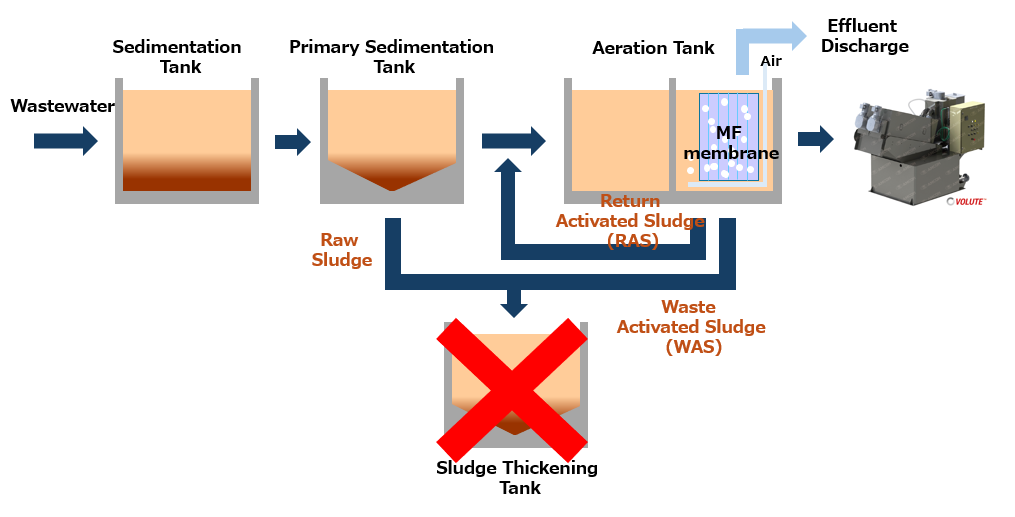
With the installation of our dewatering machine, you will be able to dewater the sludge directly from the aeration tank.
Type ④: Sequencing Batch Reactor (SBR) – A Method That Allows Flexible Operation
Sequencing Batch Reactor (SBR) is a type of activated sludge process that performs wastewater treatment step-by-step within a single tank. Over the course of 6 to 8 hours, it repeats a cycle consisting of the following phases: influent intake, reaction (aeration), settling, treated water discharge, and sludge removal (not each time).
First, wastewater is introduced into the tank and mixed with activated sludge containing aerobic microorganisms. Then, during the aeration phase, oxygen is supplied via an aeration system, enabling microorganisms to break down organic matter into carbon dioxide and water. After the reaction phase, aeration is stopped, allowing the activated sludge to settle. Once sedimentation occurs, the clear supernatant water is discharged as treated effluent.
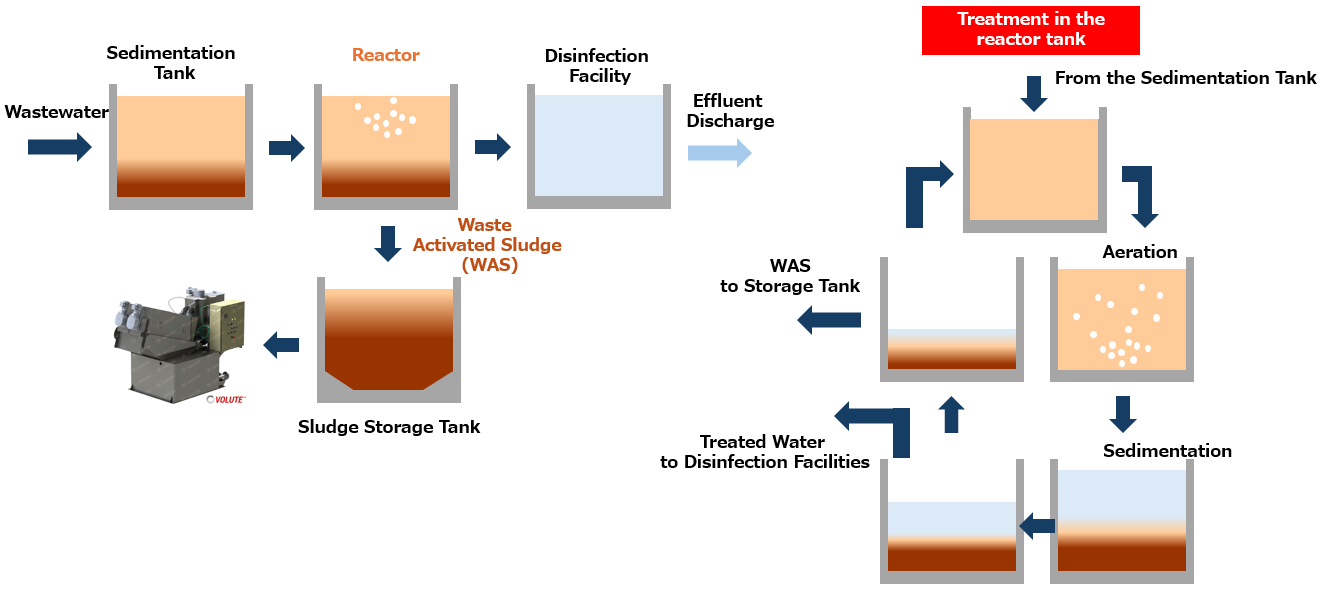
Having all processes completed within a single tank, its key advantages is that it requires minimal installation space.
General Flow of Wastewater Treatment Using Activated Sludge
The typical flow of wastewater treatment using the activated sludge process involves the following steps.
| Stages | Description |
|---|---|
| Pre-treatment | Removes large solids, oils, and other organic matter from the wastewater. |
| Aeration | Agitates wastewater with activated sludge in an aeration tank, where microorganisms break down organic matter. |
| Sedimentation | Separates treated water from flocs (clusters of microorganisms) in a sedimentation tank. |
| Discharge / Reuse | The cleaned water is either discharged or reused, depending on effluent quality standards. |
| Sludge Treatment | Part of the settled sludge is recycled, while the rest is adequately treated and disposed of. |
Key Points for Maintaining Healthy Activated Sludge
Key Points for Maintaining Healthy Activated Sludge
Maintaining the Health of Microorganisms in Activated Sludge
The effectiveness of the activated sludge process will greatly depend on the health of the microorganisms. Since many different species of microorganisms coexist, some may even cause treatment issues if not properly controlled.
To sustain a healthy microbial population, it is crucial to maintain an environment where they can thrive. This includes keeping oxygen levels appropriate and avoiding sudden changes in organic load.
It’s also important to prevent harmful substances from entering the wastewater stream. Regular monitoring allows for early detection of issues, contributing to stable and efficient treatment performance.
Maintaining Optimal Conditions for Temperature, pH, and Dissolved Oxygen
Microorganisms perform best under specific environmental conditions. The key factors include water temperature, pH, and dissolved oxygen (DO) levels.
- Water Temperature: Most microbes thrive at 20–37°C.
- pH: A neutral pH (around 7) allows microbial enzymes to function efficiently.
- Dissolved Oxygen: Aerobic microorganisms require sufficient oxygen to break down organic compounds.
Even when the facility is temporarily not operating and no influent is entering the system, it’s essential to continue supplying oxygen at a minimum level to preserve microbial activity.
Balancing Nutrients for Microbial Efficiency
Microorganisms need more than just organic matter—they also require nutrients like nitrogen and phosphorus to function effectively. A lack of nutrients can slow microbial growth and reduce treatment efficiency. Regular analysis of wastewater composition is essential. When needed, nutrient additives should be used to maintain a healthy balance. On the contrary, excessive nutrients can lead to overgrowth of certain microbes, thus proper monitoring and dosing to maintain balance will be crucial.
Prevention of Sedimentation Problems (Bulking and Floating Sludge)
Stable wastewater treatment through activated sludge will depend on the effective sedimentation in the sedimentation tank. Poor settling can lead to issues like bulking (flocs fail to settle) or floating sludge, which can degrade effluent quality.
These issues may arise due to changes in influent quality, abnormal microbial growth, insufficient aeration, or poor nutrient balance.
If problems occur in the sedimentation process, corrections—such as adjusting the operating conditions or adding treatment chemicals—should be made in consultation with specialists to restore performance quickly.
Equipment Inspections to Ensure Consistent Treatment Result
Activated sludge systems rely not only on microorganisms but also on the proper functioning of supporting equipment.
Routine equipment inspections are essential to maintain consistent treatment performance. Key points to check include:
- Blower capacity for aeration
- Pump operation for sludge transfer
- Condition of scum and sediment in the settling tank
- Pipe blockages or abnormalities
By making equipment checks a habit and addressing issues promptly, you can prevent unexpected failures and ensure the long-term stability of your activated sludge treatment system.
Conclusion|Understand and Manage Activated Sludge for Effective Wastewater Treatment
The activated sludge process includes several representative methods such as the Conventional Activated Sludge Process, Oxidation Ditch Process, and Membrane Bioreactor (MBR) Process.
In Japan, direct dewatering from OD reaction tanks using our dewatering press, VOLUTE™, is widely adopted—particularly as an effective sludge treatment solution for small-scale wastewater treatment facilities.
To ensure proper wastewater treatment, it is essential to maintain the health and stability of the activated sludge on a daily basis, while also implementing countermeasures against issues like bulking.
For inquiries, contact us here
